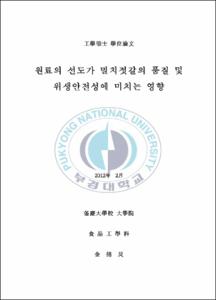원료의 선도가 멸치젓갈의 품질 및 위생안전성에 미치는 영향
- Alternative Title
- Impact of the raw material freshness on the quality & safety of salt-fermented anchovy
- Abstract
- The salt-fermented anchovy is representative of Korean marine fermented food, containing various beneficial amino acid and nucleic acid, It is known as its excellent quality, but it is difficult to secure hygiene and safety due to the backward process of manufacture and ripening. Moreover, the biogenic amine which comes from the high-protein foods such as the Korean traditional sauces and marine fermented foods could cause a big problem with human health.
A biogenic amine (BA) is a biogenic substance with an amine group produced via decarboxylation of amino acid by human, animals, plants and microorganism. Some prominent examples of biogenic amines include histamine, tyramine, serotonin and so on, especially, the histamine is a substance derived from the amino acid histidine that acts as a neurotransmitter mediating arousal. In general, all of these are known as toxic substances and formed during fermentation and decomposition. High BA contents in food could cause diseases with food poisoning symptom such as stimulating the nerves and blood vessels. Therefore, some of countries have established a guidance level of intake and study with formation mechanism and way to reducing the contents. A volatile basic nitrogen (VBN) contains mainly ammonia, trimethylamine (TMA), dimethylamine (DMA), and the level of increase with these substances by either bacteria or enzymic degradation is used as an index of freshness quality.
Thus, the aim of this study is to find out the potent way to reduce a biogenic amine by examining changes of the fresh raw anchovy Engraulis japonicus. At first, the levels of VBN and histamine at 5 and 25℃ were measured to know the effect of temperature on production of BAs. As a result, the levels of VBN significantly increased as time passed, and it showed considerable changes of its contents from 11.98 mg/100g to 88.06 mg/100g at 25 hr, and the contents of histamine also increased from 7.85 mg/kg to 1860.67 mg/100g at the same time. In contrast, when stored at 5℃, the level of VBN dropped 20 mg/100g in 4 days, and increased by 100 mg/100g after 15 days. In the levels of histamine, it revealed some changes of its contents from 79.18 mg/kg in 3 days to 202.58 mg/kg in 13 days. Based on these results, it shows that the levels of histamine is significantly associated with the freshness of anchovy.
Then, the levels of BAs, pH, total nitrogen and amino acid nitrogen were assessed to research the influence of freshness of raw material on producing BAs. To conduct this experiment, the salt-fermented anchovy was produced in 3 groups. They were divided by groups which contain 7.82-8.93 mg/ 100g, 23.5-25.0 mg/100g, and 30.7-31.9 mg/100g of the VBN contents, respectively. As a result, there were no significant differences between total nitrogen and aging period, and it showed that the levels of amino acid nitrogen, VBN and histamine were changed according to its aging period. Especially, the content of histamine sharply increased by freshness of raw materials, and it was 48.2-55.68 mg/kg, 64.58-73.07 mg/kg and 219.26-228.30 mg/kg after 90 days.
These findings suggest that the freshness of raw material influence the hygiene and safety of the final products, therefore, it is important to manage the freshness of raw material for making high quality of salt-fermented anchovy.
- Issued Date
- 2012
- Awarded Date
- 2012. 2
- Type
- Dissertation
- Publisher
- 부경대학교
- Alternative Author(s)
- Kim, Bo Kyoung
- Affiliation
- 부경대학교
- Department
- 대학원 식품공학과
- Advisor
- 조영제
- Table Of Contents
- Abstract 1
서 론 1
재료 및 방법 5
1. 원료어 5
1. 1. 시판 멸치 젓갈 5
1. 2. 멸치 젓갈 제조 5
2. 성분분석 5
2. 1. 일반성분 및 pH 측정 5
2. 2. 총질소, 아미노산성질소 및 휘발성 염기질소 측정 7
2. 3. Biogenic amine 측정 7
2. 4. 통계처리 9
결과 및 고찰 10
1. 시판 멸치젓갈의 식품 위생학적 품질평가 10
1. 1. 식품학적 품질평가 10
1. 2. 식품위생학적 품질평가 16
2. Biogenic amine 생성에 미치는 온도의 영향 18
3. 원료선도별 멸치젓갈의 식품위생학적 품질 변화 22
3. 1. 원료선도에 따른 식품학적 품질 변화 24
3. 2. 원료선도에 따른 식품위생학적 품질 변화 32
요 약 34
참고문헌 37
감사의 글 45
- Degree
- Master
- Files in This Item:
-
-
Download
 원료의 선도가 멸치젓갈의 품질 및 위생안전성에 미치는 영향.pdf
기타 데이터 / 547.24 kB / Adobe PDF
원료의 선도가 멸치젓갈의 품질 및 위생안전성에 미치는 영향.pdf
기타 데이터 / 547.24 kB / Adobe PDF
-
Items in Repository are protected by copyright, with all rights reserved, unless otherwise indicated.